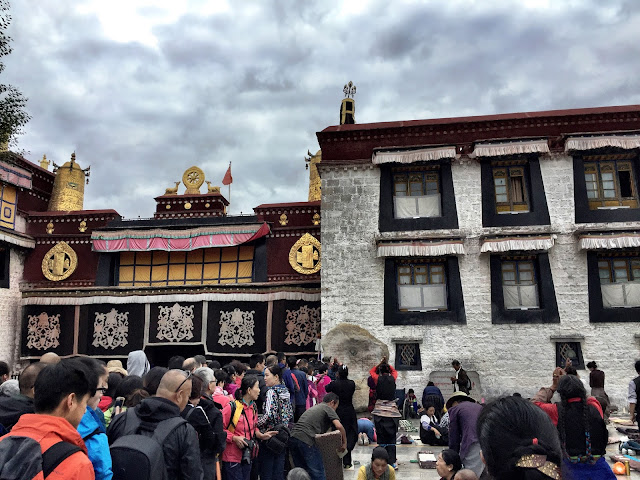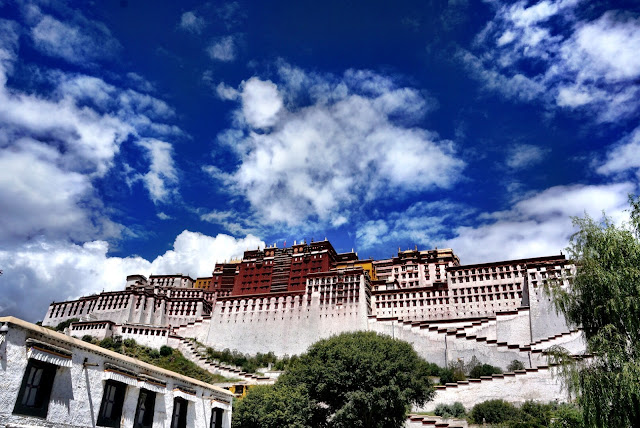Tuesday, November 7, 2017
2017-09-15 Tibet Trip, Day 8, Lhasa
We arrived at Lhasa yesterday after much trepidation. From the beginning, there were uncertainties in getting permissions to enter Tibet (it was not difficult if done by a capable travel agent). Whether everyone who signed up for the trip would be able to show up (some did drop out). For a group of mostly senior citizens, might the long bus ride to board the train be too torturous to some (it was bearable). The train tickets turned out to be harder to procure than originally thought (and traveling on two different trains was totally unexpected). But luckily other than one member holding a Taiwan passport and thus not being able to come with us to Tibet, we as a group was able to reach our destination without any incident. We all counted our blessings and felt blessed.
Because of the high altitude, many of us started taking our medication while on board the train. The train cabins were also equipped with a conduit to supply oxygen to people in need. I was aware of one member needing the oxygen. But overall, we all coped well with the trip so far. And after one night of rest, we were ready to start our tour of Lhasa.
Our itinerary for today called for visits to three holy sites. The first was the Jokhang Temple 大昭寺, the most sacred and important Buddhist temple in Tibet. The second was the Potala Palace 布達拉宮, once the residence of the Dalai Lama, now a museum and a World Heritage Site. The third was the Sera Monastery 色拉寺, a renowned training ground for Buddhist monks.
The Jokhang Temple was built in the 7th century by Tibetan King Songtsen Gampo 吐蕃王松贊干布for his two brides: Princess Wencheng of the Tang dynasty 唐朝文成公主, and Princess Bhrikuti of Nepal. Both princesses brought precious Buddha statues to Tibet as part of their dowries. The one from Tang is still housed in this temple and it is regarded by Tibetan as one of the most sacred symbols of their faith.
The plaza in front of the Jokhang Temple is called Jokhang Square 大昭廣場. We got there very early in the morning while the plaza is sparsely populated, but it got filled up very fast. Two tall flagstone pillars were very noticeable. Smoke could be seen coming out of two huge stone incense burners.
(Click on each picture to get the full-size view. Some pictures were taken by Ben, Peter, and others without explicit attribution.)
The entrance to the temple. A throng of tourists already lined up waiting to get in. The open space next to the entrance was occupied to capacity by Tibetan worshipers.
Many devout Tibetan worshipers were on the floor performing the act of prostration, paying the ultimate respect to Buddha.
Inside the entry door, four Guardian Kings were painted on the wall, two on each side.
The intricate ceiling of the walkway by the main hall.
There are many buildings in the Jokhang Temple. Each building is characterized by its shining gilt roof.
One of the perks, of being group leaders, for Philip and Simon was to have a picture taken with our lovely tour guide, Titian.
The next stop was the Potala Palace. From every angle, the palace always looked grand and majestic.
At a postcardesque location, we took our group picture.
The palace was built on a plateau so climbing up numerous steps and turning around many zigzags were required. At the end of these steps was palace’s main building, the Red Palace. Many stupa tombs of the past Dalai Lama were placed in that building.
Next major building in the palace was this White Palace. The upper part of this building was the living quarters of the past Dalai Lama. The lower part used to be the offices of the former local government.
View from the White Palace to the city of Lhasa below was spectacular.
Back view of the Potala Palace with one of its watchtowers.
The last stop for today is the Sera Monastery, a celebrated Buddhism school. Many famed monks came from this esteemed school.
The school’s method of instructions through arguments and debates was legendary.
In the evening, we chose to join an optional tour to see a stage show, Princess Wencheng. It told the story of Tibetan King Songtsen Gampo proposing to marry a princess from the Tang dynasty; how Princess Wencheng conquered all obstacles to travel thousands of miles to meet her future husband; and how the marriage pacified the hostility between the Tibet Empire and the Tang dynasty for decades. Although the storyline was simple and easily understood, the scale of the stage and the number of the performers were mind-boggling. It easily put all large Las Vegas stage shows to shame.
During the Tang dynasty, the western fronts of its territory were constantly at a warring stage with its neighboring countries. Huns 匈奴 and Tibet were constant threats to Tang’s sphere of influence in the Western Territory 西域. Tang’s military power was only on par with its adversaries, and sometimes its own army was soundly defeated and decimated.
Chen Tao 陳陶, a poet from the Tang dynasty, wrote a poem Song of Lunghsi 隴西行 about the anguish and the helplessness of its people regarding the prolonged war. The English translation of the first half of the poem was by Mr. C. K. Ho 何中堅 of Hong Kong. The second half was by very humbly yours.
誓掃匈奴不顧身,五千貂錦喪胡塵。
可憐無定河邊骨,猶是春閨夢裏人。
黠虜生擒未有涯,黑山營陣識龍蛇。
自從貴主和親後,一半胡風似漢家。
By death they swore, to send the Huns to hell;
On barbarian soil, five thousand warriors in sables fell.
How sad their bones are lying by the Wu-ding River;
In the spring dreams of many wives, their spirits still dwell.
To capture alive the sneaky enemies will take forever,
So will marching into their camps and confronting their venomous generals.
Since Princess Wencheng's marriage to pacify the unconquered,
Half their customs has become similar to our Han people’s behaviors.
Subscribe to:
Post Comments (Atom)











































No comments:
Post a Comment